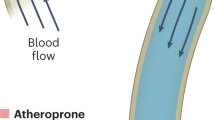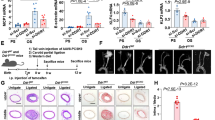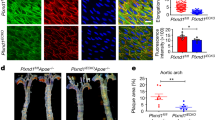Abstract
Constriction of vascular smooth muscle in response to the stimulus of raised intravascular pressure—the myogenic response1,2— represents a positive feedback mechanism which, if unopposed, could theoretically lead to instability in the intact circulation3,4. Dilation in response to increased intraluminal flow would provide an opposing feedback mechanism which could confer overall stability4. Flow-dependent dilation in conduit vessels5–7 is mediated by endothelium-derived relaxing factor (EDRF)8–14, but the relationship between flow and EDRF activity has not been studied in resistance vessels in situ. We here demonstrate that EDRF can coordinate the aggregate hydrodynamic properties of an intact network. Under control conditions, EDRF maintains a fourth-power relationship between diameter and flow so that the pressure gradient in each vessel asymptotically approaches a constant value at high flow rates. Basal EDRF release may also maintain a similar spatial distribution of flow at different flow rates, even under conditions of moderate pharmacological constriction.
This is a preview of subscription content, access via your institution
Access options
Subscribe to this journal
Receive 51 print issues and online access
$199.00 per year
only $3.90 per issue
Buy this article
- Purchase on Springer Link
- Instant access to full article PDF
Prices may be subject to local taxes which are calculated during checkout
Similar content being viewed by others
References
Bayliss, W. M. J. Physiol., Lond. 28, 220–231 (1902).
Johnson, P. C. in Handbook of Physiology Vol II Vascular Smooth Muscle (eds Bohr, D. F., Somlyo, A. P. & Sparks, H. S.) 409–442 (Am. Physiol. Soc., Bethesda, Maryland, 1980).
Folkow, B. Circ. Res. 15, Suppl. 1, 279–287 (1964).
Guyton, A. C., cited in Koch A. R. Circ. Res. 15, Suppl. 1, 269–279 (1964).
Schretzenmayr, A. Pflüeger's Arch. ges. Physiol. 232, 743–748 (1933).
Hilton, S. M. J. Physiol., Lond. 149, 93–111 (1959).
Gerova, M. et al. Basic Res. Cardiol. 76, 503–507 (1981).
Smiesko, V., Kozik, J. & Dolezel, S. Blood Vessels 22, 247–251 (1985).
Holtz, J., Giesler, M. & Bassenge, E. Z. Kardiol. 72, Suppl. 3, 98–106 (1983).
Holtz, J., Forstermann, U., Pohl, U., Giesler, M. & Bassenge, E. J. Cardiovasc. Pharmac. 6, 1161–1169 (1984).
Rubanyi, G. M., Romero, J. C. & Vanhoutte, P. M. Am. J. Physiol. 250, H1145–H1149 (1986).
Pohl, U., Busse, R., Kuon, E. & Bassenge, E. J. appl. Cardiol. 1, 215–235 (1986).
Kaiser, L., Hull, S. S. & Sparks, H. V. Am. J. Physiol. 250, H974–H981 (1986).
Khayutin, V. M. et al. Acta physiol. Hungarica 68, 241–251 (1986).
Furchgott, R. F. Circ. Res. 53, 557–573 (1983).
Griffith, T. M., Edwards, D. H., Lewis, M. J., Newby, A. C. & Henderson A. H. Nature 308, 645–647 (1984).
Griffith, T. M., Henderson, A. H., Hughes Edwards, D. & Lewis, M. J. J. Physiol., Lond. 351, 13–24 (1984).
Martin, W., Furchgott, R., Villani, G. M. & Jothianandan, D. J. Pharm. exp. Ther. 237, 529–538 (1986).
Collins, P. Chappell, S. P., Griffith, T. M., Lewis, M. J. & Henderson, A. H. J. Cardiovasc. Pharmac. 8, 1158–1162 (1986).
Davies, R. Ll., Flores, N. A. & Evans, K. T. Br. J. Radiol. 59, 273–276 (1986).
Palmer, R. M. J., Ferrige, A. G. & Moncada, S. Nature. 327, 524–526 (1987).
Gibson, Q. H. & Roughton, F. J. W. J. Physiol., Lond. 136, 507–526 (1957).
Martin, W., Villani, G. M., Jothianandan, D. & Furchgott, R. F. J. Pharm. exp. Ther. 232, 708–716 (1985).
Edwards, D. H., Griffith, T. M., Ryley, H. C. & Henderson, A. H. Cardiovasc. Res. 20, 549–556 (1986).
Zweifach, B. W. Circ. Res. 41, 380–390 (1977).
Mayrovitz, H. N. & Roy, J. Am. J. Physiol. 245, H1031–H1038 (1983).
Colquhoun, D. in Lectures on Biostatistics 259–272 (Clarendon Press, Oxford, 1971).
Gore, R. W. Am. J. Physiol. 222, 82–91 (1972).
Popel, A. S. J. appl. Mech. 47, 247–253 (1980).
Gore, R. W. Circ. Res. 34, 581–591 (1974).
Zweifach, B. W. Circ. Res. 34, 843–857 (1974).
Schmid-Shönbein, H., Fischer, T., Driessen, G. & Rieger, H. in Quantatative Cardiovascular Studies (eds Hwang, N H C, Gross, D. R. & Patel, D. J) 353–417 (University Park Press, Baltimore, 1979).
Murray, C. D. Proc. natn. Acad. Sci. U.S.A. 12, 207–214 (1926).
Kamiya, A. & Togawa, T. Am. J. Physiol. 239, H14–H21 (1980).
Colquhoun, D. in Lectures on Biostatistics 200–204 (Clarendon Press, Oxford, 1971).
Author information
Authors and Affiliations
Rights and permissions
About this article
Cite this article
Griffith, T., Edwards, D., Davies, R. et al. EDRF coordinates the behaviour of vascular resistance vessels. Nature 329, 442–445 (1987). https://doi.org/10.1038/329442a0
Received:
Accepted:
Issue Date:
DOI: https://doi.org/10.1038/329442a0
This article is cited by
-
Microchannel network hydrogel induced ischemic blood perfusion connection
Nature Communications (2020)
-
Another role for nitric oxide in blood flow control?
Medical & Biological Engineering & Computing (2011)
-
Ethnic differences in retinal microvascular structure
Diabetologia (2008)
-
The clinical assessment of retinal microvascular structure and therapeutic implications
Current Treatment Options in Cardiovascular Medicine (2007)
Comments
By submitting a comment you agree to abide by our Terms and Community Guidelines. If you find something abusive or that does not comply with our terms or guidelines please flag it as inappropriate.



